Wondering how to show your dog you love them? Integrative veterinarian Dr. Julie Buzby provides 14 thoughtful ways to show your dog just how much they mean to you. Plus, many of these ways of saying “I love you” to your dog can help strengthen your bond or keep your dog fit and healthy too.
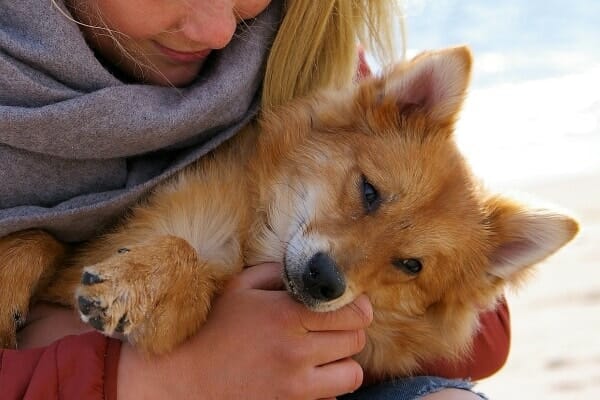
There are many ways to show your dog you love them, but which ones are the most meaningful to your faithful companion? How can you express your love, honor, and concern for your dog in ways that they will understand and appreciate?
These are good questions.
As an integrative veterinarian, it’s my mission to help you help your dog live the healthiest, happiest life possible. And part of that is helping you know how to make your dog feel loved and treasured. So I wanted to share with you my 14 favorite ways to show your dog you love them.
14 Ways to show your dog you love them
- Find your dog’s “touch love language”
- Take your dog for a daily walk (or two)
- Give your dog plenty of time to follow their nose
- Learn to read your dog’s body language
- Play games together
- Train your dog in basic obedience (and maybe some fun tricks too)
- Be consistent and use positive reinforcement
- Make or buy your dog some healthy treats
- Create a safe retreat for your dog
- Buy your dog a new toy
- Love your dog for exactly who they are
- Provide your dog with routine veterinary care
- Talk to your dog
- Fill your dog’s water bowl with cool, fresh water
Let’s take a closer look at each one of these ways to show your dog you love them.
#1: Find your dog’s “touch love language”
One way we can love our dogs—and, incidentally, the people in our lives as well—is through physical touch.
Not all dogs respond equally to physical touch. But I think taking a few minutes throughout the day to give a little ear rub, chin scratch, belly rub, or whatever they seem to like best is a meaningful way to show your dog your love. (However, keep in mind that your dog may not like a hug because hugs make some dogs feel trapped.)
Taking a few seconds (or minutes) to give your dog a scratch or rub lets you show affection to your dog in a way that’s meaningful, fun, and pleasurable for them.
In addition to intentional petting, many dogs also enjoy being in physical contact with people. They may want to lay in your lap, against your leg, or on your feet for that comforting sense of nearness. This may be in part because being pack animals originally, dogs seem to feel more safe and secure sleeping near someone than alone. But whatever the reason, being near you can help your dog know you love them.
#2: Take your dog for a daily walk (or two)
When dogs were in the wild, they traveled. They were on the move for miles and miles each day. But now in our homes, a dog’s only exercise may consist of running to the front door to greet us. This lack of physical activity is really hard on a dog’s body, mind, and spirit.
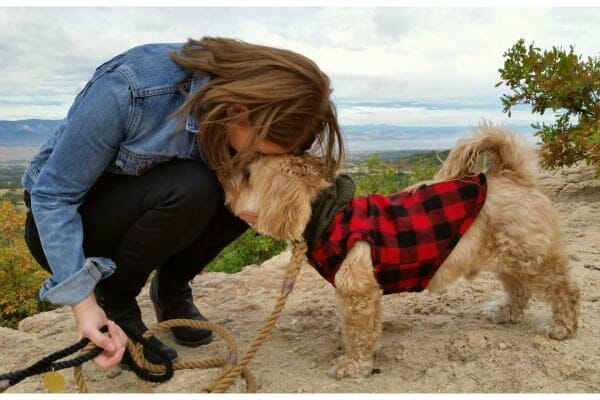
Thus, taking your dog on a daily walk (or walks) can be a great way to show your dog you love them. So can going on a hike or run or taking your dog swimming. This gives your dog a chance to stretch their legs, see and sniff the sights, and get some fresh air. And it gets you up and moving too.
In short, exercise is good for the body and the mind—on both ends of the leash.
#3: Give your dog plenty of time to follow their nose
If I had to give up one of my five senses (sight, hearing, taste, touch, smell), it would be an easy decision. I would give up my sense of smell.
Granted, I would really miss my sense of smell. For example, just the other day, my daughter was out of the shower wrapped in a fuzzy towel. I hugged her, put my nose in her hair, and nuzzled her for a moment.
And I said, “Wow! Your hair smells great!”
And my sweet little girl said, “Thanks! It’s dog shampoo.”
I would miss moments like that.
But honestly, in my line of work as a veterinarian, it may be an asset to lose my sense of smell!
For dogs, however, their sense of smell is so keen that it would probably be one of the last senses they would want to give up. I’ve read various findings and, while I’ve never been able to actually find a definitive answer, a dog’s sense of smell is certainly many, many times greater than ours. (The numbers range from 1,000 to even a million times greater than our sense of smell.) Also, the part of the dog’s brain that’s related to smell is 40 times larger than ours.
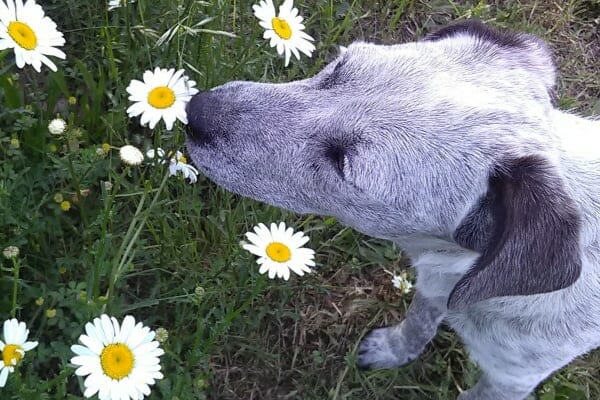
A sense of smell is crucial to how dogs perceive the world around them. And I believe that dogs derive great joy from picking up information from the world through sniffing.
By giving your dog plenty of “sniff time” in the great outdoors, you are giving your dog something most dogs truly love. So, when you’re on those walks with your furry family member, make sure to allow time for your dog to follow their nose. They’ll love taking time to stop and smell the roses!
#4: Learn to read your dog’s body language
Have you ever thought about how dogs communicate with each other or with you? Since they don’t use words, much of their communication is centered around body language. By learning how to “read” your dog’s body, you can help them feel loved and secure because you will know what they are trying to tell you.
I could write a whole article just on dog body language, but here are the basics:
- Happy relaxed dog—Eyes are soft, mouth and ears relaxed, may wag the tail in circles or in a wide sweeping motion, body is loose and fluid
- Dog on high alert–Ears perked, eyes wide open, tail may be wagging stiffly and extended, body tense with weight evenly distributed
- Nervous dog—Wide eyes with exposed whites (i.e. whale eye), stiff body or crouching, tail may be tucked or stiff, tight lips, licking lips or yawning frequently, looking away, leaning back
- Aggressive dog—Leaning forward, hackles raised, tense mouth (lips may be drawn back), making direct eye contact with wrinkled forehead, tail tucked or upright and tense.
By watching your dog’s body language, you can intervene when they are getting stressed or nervous in a situation. And you will know how your dog feels about some of the other methods for showing your dog love.
#5: Play games together
Teaching your dog a game can be a great way to help them feel loved. For example, our dog Luke, who’s a sweet guy, plays a game we call “Go Find.” He looks so happy and proud of himself while he’s playing it. Here’s what we do:
- My daughter chooses a hiding place. (When Luke was learning the game, she chose easy spots–behind a door or piece of furniture, for example.)
- I take Luke to a different place where he can’t see her hide. (Yes, I’m an accomplice in the game.)
- After my daughter has found a hiding spot, she calls to Luke.
- I say “Go find! Go find!”
- Over time, Luke has learned the cue and goes to find her. If he’s having trouble, my daughter calls his name.
- When Luke finds her, it’s a grand reunion! He’s found his person. He’s so happy and it’s fun for everybody.
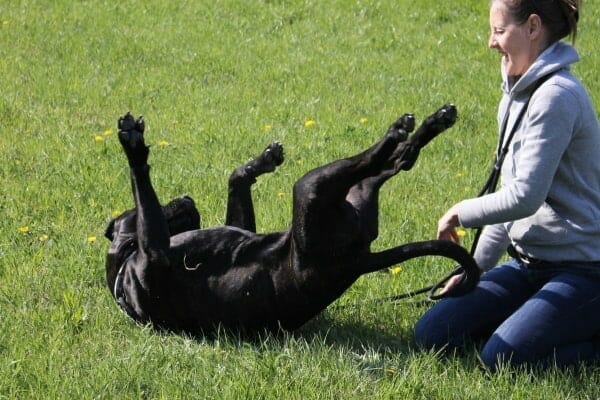
So why not love your dog through playing games! It’s a way of investing quality time, stimulating your dog’s mind, and enjoying doing something fun together.
#6: Train your dog in basic obedience (and maybe some fun tricks too)
Spending time training your dog is a great way to show them you love them for multiple reasons.
- It provides a way to spend some quality time together and only requires a few minutes at a time. Several short training sessions of approximately 5-10 minutes throughout the day tend to be ideal.
- Learning new tricks or practicing old ones provides great mental stimulation.
- Training strengthens your bond with your dog.
- Having your dog know how to sit, stay, walk on a leash, and perform other basic obedience tasks helps your dog be a model canine citizen when out and about or meeting new people. This makes it easier to take your dog places.
There are a variety of tricks online that you can learn to teach your dog. Or you could consider enrolling in an obedience class with your dog. (Just stay away from fear or dominance-based training and look for a class that uses positive reinforcement.) Both the DIY approach and participating a formal training class together can be a great way to show your love to your dog.
#7: Be consistent and use positive reinforcement
As pet parents, it’s important that we’re consistent in what we ask our dogs to do and the boundaries that we give them to live within. Recently, I hurt my dog’s feelings (and that may sound like anthropomorphism, but I could see it my little dog’s face) when I expressed disappointment for a behavior that he didn’t realize was off limits. I was inconsistent. One time I let him get away with the behavior, and the next time I discouraged it.
I’m not saying you can’t change the rules. What I am saying is to establish the rules and be consistent. And ensure that you are using positive reinforcement (e.g. treats or praise) to mark desirable behaviors so that your dog knows when they are doing things right.
Being able to know what to expect from you and being rewarded for good behaviors can go far in showing your dog you love them.
#8: Make or buy your dog some treats
Since our culture does equate food with love, giving treats to our dogs as a sign of love is common. And this is fine in moderation. There is nothing wrong with occasionally making a batch of pumpkin dog treats or picking up your dog’s favorite treats at the store. After all, who doesn’t love how excited some dogs get about treats? And they can be a great way to reinforce good behavior too.
However, you need to remember that treats should make up no more than 10 percent of a dog’s daily caloric intake. Otherwise your dog could run the risk of becoming an overweight dog or not getting all the necessary nutrients from their dog food due to filling up on treats.
#9: Create a safe retreat for your dog

Many dogs enjoy being with the people they love, but they may also want to be able to “get away” from the action a bit too. One way you can help your dog do this (and show you love and understand them) is by creating a comfortable retreat area for your dog where they can feel safe.
For some dogs, this is the crate. For others, it might be a dog bed placed on the periphery of the main living area so the dog can relax and observe without being right in the center of things. And for dogs who enjoy a bit more peace and quiet, their “safe zone” could be a dog bed (or human bed) in a bedroom or office where they can escape the chaos entirely for a bit.
With eight kids (six of which are boys), my house is always loud and hectic. And most of the time, my dogs love that. But they also seem to appreciate having space to get away for a bit too. My kids all know that when the dogs are in their beds or crates, they are not to bother the dogs. And when the dogs are up and about, they can carry on with playing with the dogs, petting them, etc.
#10: Buy your dog a new toy
For dogs who love toys, getting a new toy can be quite exciting. Whether you take your dog to the pet store to pick out a new squeaky toy or present them with a puzzle toy or safe chew toy for dogs, toys are a great way of showing your love.
The great thing about toys, too, is that they can keep your dog occupied (sometimes for hours) and help satisfy the need for mental stimulation, chewing, and licking. Just ensure that your dog cannot swallow the toy, choke on it, or fracture any teeth chewing on something that is too hard (e.g. antler chews for dogs).
#11: Love your dog for exactly who they are
Of course you love your dog. But have you ever wished they were a bit different? Perhaps a bit more like a previous dog, or what you envisioned this dog would be like?
When you adopt a puppy, or sometimes even an older dog, you don’t always know what you are going to end up with. That can be part of the fun. But if you had specific ideas of what you wanted to do with that dog (e.g. therapy dog work, agility, etc.) and your dog isn’t well suited for that pursuit, it can sometimes be a challenging adjustment. Or if you expected that getting another dog of the same breed would be a similar experience to your first dog of that breed, you could easily be disappointed.
Each dog is a unique individual, and that makes them special. So rather than thinking about what could have been, focus on what you do have. Take some time to reflect on your dog’s personality and strengths and then find ways to capitalize on them. Maybe it means getting into scent work instead of retrieving. Or accepting that a walk around the block, not a 5-mile run, is more in your dog’s wheelhouse. Whatever it is, remember to love and appreciate your dog for exactly who they are at that time.
#12: Provide your dog with routine veterinary care
Dogs may not always love going to the vet. But partnering with your vet to help your dog live as long, healthy, and happy of a life as possible is still an important way to show your dog you love them. This involves:
- Following your vet’s recommendations on how often you should take your dog to the vet for a wellness visit.
- Administering parasite preventives (e.g. those to prevent heartworm disease in dogs or control ticks that could carry tick-borne disease in dogs) on a routine basis.
- Permitting your vet to run fecal tests for dogs, blood tests for dogs, or other screening tests at the recommended intervals.
- Performing an at-home dog wellness scan weekly so you can catch problems early.
- Talking to your vet about any concerns or questions you may have about your dog.
- Working with veterinary specialists near you if your dog experiences complicated medical issues.
- Trying out some of my tips for vet visits if your dog gets stressed at the vet.
#13: Talk to your dog
Some skeptics—probably not anyone reading this post because you understand me and we share common ground—may scoff and suggest that dogs do not understand the words “I love you” or most other things we say to them.
But here’s what I know to be true. Dogs may not understand word for word what we’re saying, but they absolutely understand our tone and intent.
Interestingly, a 2018 study in Animal Cognition indicated that using dog-directed speech (i.e. baby talk) and some words the dog was familiar with seemed to increase the dog’s attention and the bond between the person and dog. So if you like to talk baby talk to your dog, keep on doing what you are doing!
But whatever voice you decide to use, the big point here is to keep talking to your dog, even if they can’t hear you or you aren’t sure if they understand you. I’ve had many, many patients with hearing loss in dogs over the years. (At this stage of my life, my patients are predominantly senior dogs.) Many times as I’m examining a dog, the owner shares that the dog can’t hear me. I nod in understanding and continue whispering sweet nothings in the dog’s ears.
I explain that, while the dog might not be hearing my words, by simply speaking them, I am communicating an intent. Dogs pick up on that. I have no doubt.
Whether it’s “I love you” or other heartfelt phrases, words of affirmation really do mean a lot to our dogs. I believe this wholeheartedly. So why not take a moment to tell your dog in words just how much you love them.
#14: Fill your dog’s bowl with cool, fresh water
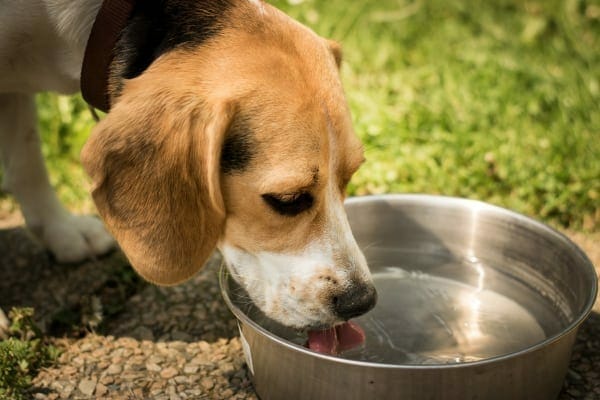
It may seem obvious, but fresh water is a simple way to show your dog love.
We all have different numbers of dogs that live in our homes. My family has three dogs. When I give my dogs a bowl of fresh water—cold from the tap—they get really happy and excited about it. Almost as excited as if I’d given them a dog treat. Plus, staying hydrated is key to the health of many body systems in our dogs.
Therefore, you can show your dog you love them by:
- Making a point to change your dog’s water often.
- Filling your dog’s bowl with cool, fresh water.
- Running your dog’s bowl through the dishwasher to disinfect it and get rid of any slime build-up.
Thank you for loving your dog!
Belly rubs. Games. Walks. Loving words. All of your actions and words speak volumes to your dog! They all say “I love you” in ways that your dog will appreciate and understand. That’s happiness for your dog.
Chances are good you are already doing many of the things I shared to show your dog you love them. But why not pick something new from the list and try it out? Chances are, your dog will love it. And they will know you love them too!
Did you know you can listen to my podcast to hear more about how to show your dog you love them?
The complete story of this article on how to show your dog you love them is available on my podcast. In addition to sharing more advice on ways to love your dog, I recount the late-night “slushy emergency” that was the inspiration for the post. I hope you’ll listen in as I talk about driving to our neighborhood gas station in search of a blue-raspberry slushy for my feverish son who looked so sad and said, “Mom, can I please have a slushy?”
Tap the green arrow, to listen…